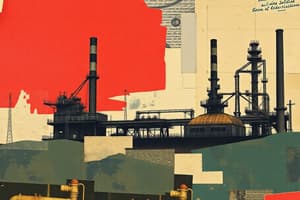Podcast
Questions and Answers
Hydrogen sulfide (H2S) is a:
Hydrogen sulfide (H2S) is a:
- Compound and a mixture
- Molecule and an element
- Molecule and a compound (correct)
- None of the above
A solid has a fixed shape because:
A solid has a fixed shape because:
- Particles slide past one another
- Particles vibrate in place (correct)
- Particles move rapidly
- None of the above
Hydrocarbons, which are composed mostly of hydrogen and carbon, are considered:
Hydrocarbons, which are composed mostly of hydrogen and carbon, are considered:
- Organic materials (correct)
- Elements
- Compounds
- Inorganic materials
Negatively charged particles that move around the nucleus are called:
Negatively charged particles that move around the nucleus are called:
Carbon's atomic number is 6, which means that it has:
Carbon's atomic number is 6, which means that it has:
When a chemical bond is formed, _______ are transferred or shared between atoms.
When a chemical bond is formed, _______ are transferred or shared between atoms.
Biomass is considered a:
Biomass is considered a:
Which of these particles can be found in the atomic nucleus?
Which of these particles can be found in the atomic nucleus?
Which of the following is considered a pure substance?
Which of the following is considered a pure substance?
What is the state of diesel fuel at room temperature?
What is the state of diesel fuel at room temperature?
Which of the following is a type of matter?
Which of the following is a type of matter?
Which of the following particles is described as the basic building block of matter?
Which of the following particles is described as the basic building block of matter?
Which of the following BEST describes the location of electrons within the atom?
Which of the following BEST describes the location of electrons within the atom?
Which element has 50 protons?
Which element has 50 protons?
What is the relationship between two atoms that each have 20 protons and 20 electrons but different numbers of neutrons?
What is the relationship between two atoms that each have 20 protons and 20 electrons but different numbers of neutrons?
Flashcards are hidden until you start studying
Study Notes
Hydrogen Sulfide (H2S)
- Hydrogen sulfide is a toxic and corrosive compound found in crude oil that requires removal during refining.
- It is a molecule with a fixed ratio of atoms, consisting of two different types of atoms, making it a compound.
Properties of States of Matter
- The macroscopic properties of solids, liquids, and gases derive from the microscopic behaviors of particles.
- Solids maintain a fixed shape because their particles vibrate in place, while allowing slight movement.
Fossil Fuels and Hydrocarbons
- Fossil fuels are primarily made of hydrocarbons, which are organic materials composed of hydrogen and carbon.
- Hydrocarbons highlight the organic nature of fossil fuels.
Atomic Structure
- Electrons are negatively charged particles that orbit the nucleus of an atom.
- The atomic number of an element, such as carbon, indicates the number of protons; carbon has an atomic number of 6, which corresponds to 6 protons.
Chemical Bonds
- Chemical bonds involve the transfer or sharing of valence electrons between atoms, crucial for bond formation.
Biomass
- Biomass, consisting of waste material like garbage and manure, is classified as a mixture due to its diverse composition of compounds.
Atomic Nucleus
- The atomic nucleus contains protons and neutrons, fundamental components that define the atom's structure.
Pure Substances
- A pure substance is characterized by having a uniform and definite composition; ice in water exemplifies a pure substance as it consists of one compound.
Diesel Fuel States
- Diesel fuel, at room temperature, is in a liquid state where its particles are closely packed but capable of sliding past each other.
Matter Definition
- Air in a balloon qualifies as matter as it occupies space and has mass, while electricity is classified as energy rather than matter.
Building Blocks of Matter
- Atoms are recognized as the fundamental building blocks of matter, forming the basis for all substances.
Electron Location
- Electrons exist in orbits or an electron cloud around the nucleus, which contains protons and neutrons.
Tin Element Identification
- Tin (Sn) is identifiable by its atomic number of 50, denoting 50 protons within its atoms.
Atomic Relationship
- Two atoms with the same number of protons and electrons but different neutron counts represent isotopes of the same element.
Studying That Suits You
Use AI to generate personalized quizzes and flashcards to suit your learning preferences.




